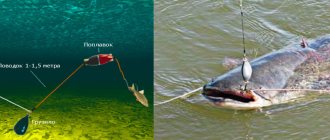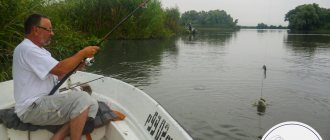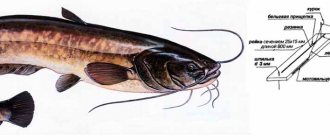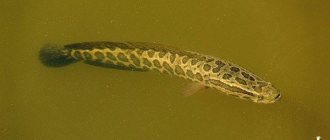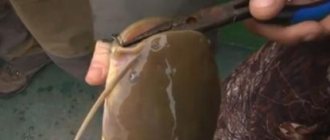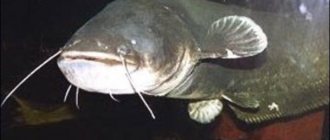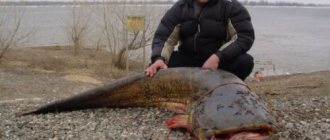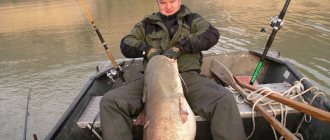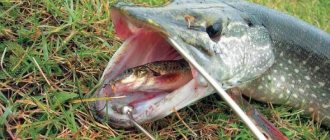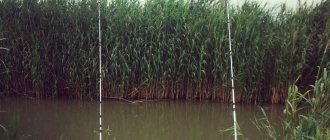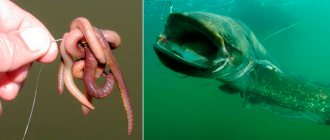Among the variety of live baits, frogs, of course, are not in the forefront as a universal and catchable bait for any fishing conditions. This type of live bait can only be used to catch some species of predatory fish that inhabit our freshwater bodies. It is gratifying that one of the leading positions in this list is held by catching catfish with a frog. For the river giant, these amphibians are considered a natural tasty dish, which it will not disdain, despite the current nutritional situation. As soon as the temperature regime of the reservoir activates the predator itself, and at the same time its prey, you can immediately plan fishing using this type of live bait.
Having knowledge in the field of assembling catfish fishing devices and being able to determine the habitat of a predator, catching a catfish with a frog is a very real idea. Fortunately, you can post these types of amphibians right on the reservoir in unlimited quantities, without particularly bothering with the process. You can get acquainted with the main nuances of catching a mustachioed predator for this specific type of live bait from the article presented below for the attention of the fisherman, which provides information on the technology of fishing for frogs, their extraction and storage.
The article, which will be useful for a fisherman, pays special attention to such an element of fishing as fishing, which requires a special approach due to the size of trophies caught in baited catches.
Where to fish and how to prepare
It is most effective to catch catfish using bottom fishing methods, using girders or classic corded bottoms. A fish such as catfish leads a bottom-dwelling, sedentary lifestyle, practically never leaving its usual habitat throughout the entire period of its existence. Whiskered predators prefer deep holes and ditches, looking for submerged snags, tree trunks, abandoned building structures and sunken boats for shelter. The predator likes to settle in backwaters, at the boundaries of mixing water currents of different strengths with access to shallows, where it regularly visits to feed at night.
Using a frog as live bait, catfish are caught on stationary girders installed from the banks at promising fish exit points or on corded bottoms, which are mounted on flat underwater plateaus connected closely by pits located in the waters of the reservoir. These weapons are mostly used for hunting in the dark. Fishing with quok is carried out during daylight hours. This method requires a boat, which is floated along a trajectory directly above the predator’s parking areas, pits and underwater ditches.
Fishing begins from the moment of mass release of amphibians, approximately from the second half of May until the beginning of the autumn cold, when tree frogs begin to hide and go into suspended animation. For bait, large specimens weighing from 80-100 grams with bright colors and active behavior are selected. Although among fishermen there is no consensus about the mandatory survivability of the bait, because some fishermen specifically kill the bait, leaving it in the heat until signs of spoilage appear, or even lightly frying the frogs. On most rivers, catfish are more effectively caught using live bait.
How to catch catfish on a donk
Having chosen a promising fishing spot, the fisherman begins to install the gear, starting its installation no later than a couple of hours before the onset of evening, because the time of evening twilight and the first half of the night are the most catchy in relation to other parts of the day. Next, we will consider the technology and technique of fishing when using various types of gear, specifying the important aspects of the execution of the main elements of fishing.
Small catfish must be released
With a rod
Having installed a stand for the rod on the shore and equipped the hook with a nozzle, cast the tackle, paying attention to the accuracy of the bait, in view of its possible dislocation with an excessively strong swing and subsequent impact on the water. After tensioning, the cord is equipped with an alarm and a bite is expected.
Catfish bite sharply, picking up the bait and continuing their movement without pause. Such a pull should be immediately accompanied by a hook and, sensing the resistance of a fish that has landed on the hook, you must promptly begin to land it. Fishing is carried out with a reel, gradually winding the cord and tiring the fish by pulling the form in the direction opposite to the trajectory of the fish. The mustachioed predator is quite strong and resilient, and the fight with a large individual can continue with varying success for dozens of minutes, and sometimes even hours.
After tensioning, the cord is equipped with an alarm and a bite is expected. Catfish bite sharply, picking up the bait and continuing their movement without pause. Such a pull should be immediately accompanied by a hook and, sensing the resistance of a fish that has landed on the hook, you must promptly begin to land it. Fishing is carried out with a reel, gradually winding the cord and tiring the fish by pulling the form in the direction opposite to the trajectory of the fish. The mustachioed predator is quite strong and resilient, and the fight with a large individual can continue for dozens of minutes, and sometimes hours, with varying success.
Read Tuning a PVC boat with your own hands
Tired fish are identified by the release of bubbles to the surface, which is the moment for more decisive action to reel in the line. The best technique is to drag the trophy onto a flat bank. Small catfish are immediately placed on the kukan. The large fish are caught in the head area with a humanizer and after this manipulation the hook is released and the specimen is croaked, placing it on a rope near the shore.
Without a rod
It is more convenient to cast a classic donkey by placing a load from the boat. In this case, the live bait remains guaranteed to be intact, and the tackle itself is controlled for installation in order to avoid tangling of the leads. Biting, like hooking a fish, is similar to the previous fishing method, but fishing has significant differences. Catfish from the shore are taken on a classic donka with strict control of laying the extended cord in a certain place, in a way different from rings and loops. The hunter must wear overalls on his hands to prevent cuts from the fishing line. Sudden withdrawals of fish are accompanied by the fisherman lowering a small amount of line and then holding the fish, which must be repeated until the resistance of the predator subsides. They take catfish into the landing net close to the shore. You can use a net only after catching an individual no more than five to seven kilograms. A large predator is pulled ashore by grabbing it in the shallows with their hands under the gills or taking it by the lip.
How to catch and where to get a frog
The search for suitable bait should be done in the coastal zone of the fished reservoir. Tree frogs love to inhabit coastal areas densely overgrown with aquatic vegetation with areas of shading and shallow depths.
Important! Duckweed on the water is a sure sign that amphibians live in these waters.
Catching frogs can be done in several ways. The easiest way is to collect live bait with your bare hands. To do this, the fisherman will need a certain skill and attentiveness required to track and catch live bait. It’s easier to catch baby frogs with a net, which can be done both in the water and by looking for specimens suitable for bait right on the shore. For fishing, you can use a fishing rod equipped with a fishing line and a small hook. A piece of a worm, maggot, fly or any other insect living near a reservoir is placed on the hook and placed directly under the nose of a potential bait spotted in the water. The frog rushes to the bait and becomes easy prey for the fisherman.
If fishing is carried out over several days, you can use the time-tested method of collecting amphibians. For these purposes, in the evening, they dig a small hole, half a meter deep, near the shore, covering its bottom with fresh grass. During the night, the frogs will gather in an improvised trap, and in the morning the fisherman will have to select specimens suitable in size for bait, guaranteed to continue fishing.
Where and how long can you store a frog?
Frogs cannot be classified as bait that has a long shelf life. An amphibian, once in captivity, quickly loses its activity and attractive color. This is caused not only by the stress of being caught, but also by the fact that frogs are quite voracious in nature, constantly hunting and feeding heavily, thereby maintaining a high degree of activity.
Catfish are reluctant to bite on a passive frog, and only during periods of high feeding activity can positive results be expected. These conditions force the fisherman to constantly stock up on fresh live bait, keeping it in captivity for no more than half a day. The attractiveness of live bait, even in this short period of time, can be achieved by placing amphibians in a voluminous plastic container with a lid. The bottom of the container is covered with grass and a little water is added, creating a level of about 5-7 cm. Water must be taken from the reservoir where the live bait was caught, trying to replace it every 2-3 hours. Cana with live bait are stored in a cool, shaded place from the sun.
How to bait a frog
There are two main ways to bait live bait. Moreover, both of these options do not hinder the natural movements of the amphibian and allow it to maintain its viability for a long time. I would like to immediately draw your attention to the fact that for installing frogs into a rig, a hook with a long shank is required. The simplest and fairly easy way of baiting is considered to be a through puncture of live bait into the thigh of the hind leg. This method does not cause serious damage to live bait and does not hinder its movements.
The second method is inherent to already experienced somyatniks. The technique involves mounting the tree frog behind the skin of the back. This requires caution and skill in baiting, since due to inexperience, damaging the animal’s spine can completely immobilize it, thereby depriving the bait of its attractiveness to a predator. If the fishing strategy involves fishing with a dead bait, the most practical and effective way is to mount the amphibian by piercing the hook through the mouth.
Technique for catching catfish with a frog
Catching catfish from the shore with a frog is carried out on stationary girders or so-called hangers, installed by attaching bushes, tree branches or specially prepared poles hanging over the promising fishing point, which are stuck into the shore or bottom of the reservoir. Depending on the activity of the predator, bait is placed both at the very bottom of the reservoir and in the water column, determining the horizons that are promising for bites.
The technique of fishing with girders brings the best results in the dark, when catfish approach the coastlines to feed, leaving their main shelters located in water areas more distant from the coast. Kwok is more effective during the day. Fishing is carried out using a line tackle held by the fisherman in his hands with simultaneous nodding, that is, attracting fish with a peculiar sound to the fishing zone attached to the hook of the bait. Baiting is carried out at the speed of the current, floating on a boat above the hole, delivering the bait to the middle horizons of the water. For the convenience of fishing these days, many fishermen use an echo sounder, which tracks not only changes in bottom topography, but also gives the fisherman information about the presence of an active predator in the hunting zone, rising from the depths to the sound of a quok and bait bait that attracts it.
The nuance of fishing for amphibians, regardless of the fishing method, is the fact that the amphibian, due to its physiological characteristics, can stay under water for no more than half an hour. Otherwise, the live bait suffocates and becomes of little interest to the predator.
Important! To ensure the duration of use of the bait, it is recommended to take out the live bait after half an hour of fishing, allowing it to catch its breath for at least 5-10 minutes, after which you can safely return the rig to the fishing point.
This technique allows one specimen of live bait to be fished for 10-12 hours, after which the frog is replaced with fresher material.
Artificial baits for spinning fishing
In addition to animal baits, bait for catching catfish can be of artificial origin.
Colors often play a secondary role, since the color schemes of baits at depths are hardly noticeable to fish, which are not particularly vigilant. Regarding spinning fishing methods, it is worth noting that hunting for catfish is promising using the trolling method, jig and casting. In this case, powerful and reliable fishing equipment is used, capable of withstanding a couple of hours of struggle with huge fish that actively resist when caught.
Wobbler
One of the best types of artificial baits today are wobblers. Manufacturers have developed a number of model lines of deep-sea wobblers specifically designed for trolling catfish fishing. These are deep-sea fats and shads that have factory settings for low-frequency play with noise chambers built into their bodies, which are filled with metal balls. These balls not only create sounds that are attractive to catfish, but also balance the bait, making the stroke uniform in frequency and stable during its retrieval, and also, when casting is necessary, long-distance delivery.
Wobblers are equipped with a powerful and large shovel, sometimes with a lead load in its front part. The mass of such a tool exceeds 20 grams with a length of 12–15 cm, and the depth parameters can reach tens of meters. In shallow waters, spinning anglers use large wobblers such as minnows or cranks, capable of going 2.5-3 meters deep.
Silicone
You definitely won’t need bait for catfish if you find the predator’s parking areas and make spinning wires using large silicone. Solid catfish are great for jigging using twisters and vibrating tails loaded with stationary jig heads with a massive and durable hook. For this type of fishing, large silicone baits with a length of 12 cm and above are chosen, loaded with masses capable of delivering the bait to the bottom as quickly as possible.
Read Winter fishing rods
For passive biting, they switch to using edible silicone, reducing the size of the bait. Color, just like when choosing a wobbler, is not a decisive factor in success; to a greater extent, the fish are lured by the blows of the jig on the bottom and the vibrations from the dotted movement applied to the parking area of the simulator predator.
Spoon
Oscillating spoons are considered a promising bait for catfish, especially in summer. Heavy and massive lures in the form of a classic spoon shape are suitable for fishing for mustache. Good indicators in terms of the number of bites are shown by double spinners, which, when retrieved, produce a peculiar metallic clattering sound that provokes the predator. The color design uses dull silver and copper colors of the instrument. Slowly moving the spoon with stops near the very bottom rarely activates the nearby catfish. In shallow waters, up to three meters deep, the use of large rotating spoons is justified at night. The fifth number of Mepps classic spinners and similar variants of spinners from other brands will be in demand in the arsenal of the spinner, without being an extra, over time having caught trophies in the standings.
Fishing
For the most part, the tackle for catching catfish with a frog is a purely corded device, used in practice without a rod. Fishing for often quite heavy fish has a number of features related to ensuring the safety of the fisherman himself, whether fishing from the shore, or even more so from a boat. It’s safer to go on catfish fishing trips with a companion who can provide backup in case of unusual situations, which is a very common thing when fighting large catfish. After feeling the bite, they make a sharp hook, detecting the fish, and then begin to lift it from the depths. The cord is constantly kept under tension, preventing the fish from moving into cover and tangling the tackle.
Important! Do not wrap the cord of the tackle around your hand in any way. A large catfish, as a result of a struggle, can easily pull even a massive fisherman into the water.
When tiring the fish, they try to give it as little free line as possible. The proximity of the end of the fight is noticeable by air bubbles beginning to rise to the surface of the water, signaling that the catfish is exhausted from the fight and will soon be brought to the surface of the water. After rising to the surface, the predator is purged, and small specimens are picked up in a landing net. To be sure, when fishing, a fisherman should have a humanizer, which is used to stun the trophy and after that they put it on the kukan, securely tying the device to a tree or other massive object, releasing the prey to the shallows.
How to make donka for catfish
The construction of bottom gear requires a certain approach to the reliability of the material used in the collection. Since the catch can be significant in size and weight, and even provide strong resistance when fishing, you must initially plan on using accessories with an increased durability life. The thinness and miniature size of the equipment will allow you to attract and force the catfish to take the bait, but it will be almost impossible to remove it from the water. Somyatniks, adequately understanding these contradictions, consciously and deliberately go for the device of rougher installations, thereby reducing the likelihood of a bite, but increasing the success of capture. Let's look at how to properly make a donk for catfish using the example of the options for selecting elements of tackle recommended below, focusing on describing the characteristics and parameters of each of them in more detail.
Fishing rod for catfish
Crocodile rods are often used for catching catfish on a donk.
As reliable rods, we advise you to choose feeder versions of heavy carp plug gear no longer than three meters with high tests and medium types of action, which will allow you to quickly hook a fish that has taken the bait and at the same time, without fear of breakage fishing rods, exhaust the fish with a long struggle, using the ability to absorb shocks with a soft form of tackle. Reinforced rings, as well as the massive butt of the fishing rod, should not confuse the fisherman, because the intended catch will not tolerate the thinness of the tackle and will crush it at any opportunity.
Reel for catfish
Like the rod itself, the catfish reel is borrowed from carp fishing. The tackle is equipped with a massive spinning rod with a capacious spool and the ability to clip the cord. The volume of the spool should easily be able to accommodate hundred-meter sections of braided cord with a diameter of at least 0.3 mm. A prerequisite is the presence of a baitrunner reel and, of course, a friction brake in the device, which will protect the gear from loss and help more efficiently deal with caught fish.
Fishing line for catfish
Rigid braided cords are more efficient in catfish fishing, allowing for finer control of fishing and providing a reliable feeling when fighting strong fish. Damping the efforts of a caught trophy is largely entrusted to the rod and reel, but preserving the catch directly depends on the parameters of the fishing line. Braided cords are used, starting from 0.3 mm. The color of the braid does not play a significant role, but shades of green tones are more acceptable, less noticeable in warm, algae-colored standing summer waters. At least one hundred meters of fishing line are wound onto the spools, avoiding knots and abrasions in its structure, which will significantly reduce the breaking loads of the accessory.
Hooks for catfish
Features of catching large catfish are the ability to use large and elastic hooks that reliably resist bending. On donks, hooks with a long shank made of thick wire and a sealed ring of a fastening element are used.
The sharpened edge of the accessory allows you to avoid idle bites when the fish tries the bait, squeezed by the predator’s mouth in the area of the brush made of small and hard teeth.
Sinker for catfish
Lead forms in the form of cones and pyramids with the possibility of being firmly attached to the fishing line of the tackle are used as weights for hooks. Weights are selected based on the weight of the bait and casting distance
The method of mounting the load using the blind method does not in any way affect the number of bites, because even small catfish can easily lift hundred-gram lead ingots when biting without regard for caution, but it adds reliability to the gear, eliminating unnecessary friction of sliding loading options on the surface of the cord. When catching catfish from a boat on a donk, especially for elastic, it is possible to use a load in the form of a brick or other object that exceeds the weight of even a couple of kilograms

